Wisteria is one of those plants that have a serious wow factor. The purple flowered vine has a way of draping itself over structures in a way that makes you feel like you’ve fallen into a story book or some kind of faraway place.
It feels like the stuff that fairytales are made of (and fairytale gardens for that matter). With this plant in your garden, you can feel like a kid every day (no growing up required here).
In our how to grow and care for guide, we’ll take a look at the different Wisteria varieties, what this vine needs in terms of light, soil, water and pruning, how to propagate your own wisteria vine either from cutting or seeds, and pests to be aware of.
More...
Genus: | Wisteria |
|---|---|
Common names: | Wisteria, Chinese wisteria, Japanese wisteria, American wisteria |
Family: | |
Plant type: | Vine |
Size: | Up to 7.5 metres long and 2.5 metres wide |
Sun: | Full sun, partial shade |
Soil type: | Well-drained |
Soil pH: | Slightly acidic to neutral |
Maintenance level: | Medium |
Poisonous to pets: | Yes |
Getting to Know Wisteria
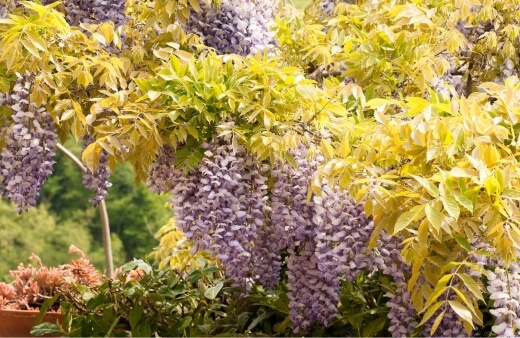
The Wisteria vine has its roots in Asia and eventually made its way to America and Europe in the 1800s. The name of the Wisteria was chosen by botanist Thomas Nuttall in the 19th century.
Thomas’ choice was to name the vine after Dr. Caspar Wistar. He was a very well-known physician at that time. Wisteria has a sort of magic about it – long stems of divine smelling flowers in the springtime in a colour palette that feels like a watercolour painting.
Shades of blue and purple, pink and white add a romance to this vine, which has pods that come after the flowers and leaves that make you think of a feather. Perfumed and pretty – I couldn’t think of a better description for a vine.
Wisteria Species
There are three species of Wisteria – Chinese, Japanese and American. Let’s take a look at these in a bit more detail.
Chinese wisteria (Wisteria sinensis)
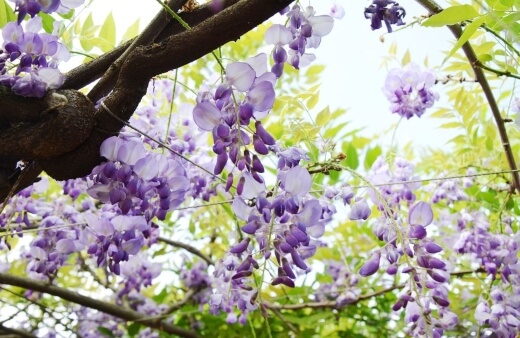
This species grows to about 7.5 metres in height and flowers from early spring to early summer. It doesn’t handle cold very well. The flowers usually appear before the leaves and they open up over a couple of weeks.
What’s great is that the flowers of the Chinese variety actually last longer than the other types.
Popular Chinese varieties include:
- W. sinensis ‘Jako’ has big and very scented flowers, about 30 centimetres in size. The flowers are white and arrive before the leaves do in late spring.
- W. sinensis ‘Prolific’ has blue-violet flowers that grow in clusters about 30 centimetres in length.
Japanese wisteria (Wisteria floribunda)
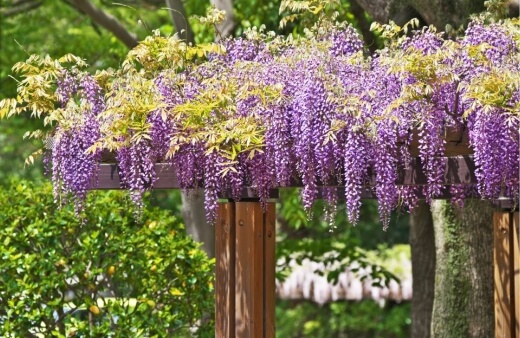
This species can grow to a height of up to 9 metres. It produces long chains of flowers which have a strong scent. They are also the most colourful of the Wisteria varieties.
The leaves are shades of bronze and green and then turn yellow in autumn. The flowers are shades of blue, light and dark purple and white. Wisteria floribunda is ideal for a cold climate.
Popular Japanese varieties include:
- W. floribunda ‘Macrobotrys’ has long clusters of flowers that reach up to a metre long. The flowers look like peas and are lilac and violet.
- W. floribunda ‘Rosea’ (Pink Japanese Wisteria) is a delightful rose colour with purple tips.
- W. floribunda ‘Royal Purple’ is one of the darkest purple wisteria with divine smelling flowers that can be 50 centimetres in size.
American wisteria (Wisteria frutescens)
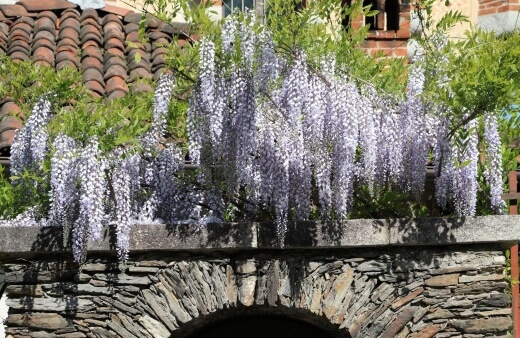
This is the smallest species and has the shortest flower stems of all the Wisteria. The flowers are a purple blue colour and don’t have a very strong fragrance. This variety is found mainly on the East Coast of the USA.


Get Your Free Guide:
Master Growing Australian Natives eBook
A Must Have Complete Guide for Every Australian Garden
Get Your Free Guide:
Master Growing Australian Natives eBook
A Must Have Complete Guide for Every Australian Garden
The flowers of this variety only arrive after the leaves are fully developed. This also means the length of the flower clusters are not as long as the Asian varieties of Wisteria.
The flowers are a blue violet colour and could be called the prettiest of all the wisteria flowers.
How to Grow Wisteria in Australia

The best time to planting wisteria is in spring or autumn. The vine needs its own space and shouldn’t be planted too close to other plants in case it takes over the territory.
This plant loves to climb things and any kind of structure is game. Something strong for it to climb is a must – wood or metal is perfect. The vines get very heavy when they mature.
Sunlight Needs
Sunlight and happy wisteria go together so plant in full sun. The vine can handle part shade but you might not see many flowers.
Soil Preference
If you give this plant well-draining soil, you’re on the right track. The wrong soil can undo all your best efforts in terms of care.
Caring for Wisteria

Watering Wisteria
You can water regularly until the plant is established and then after that, only when the weather is dry. If there is a drought, you can water every week.
What Fertiliser to Use
This plant does well with a fertiliser that is high in phosphorus and doesn't fertilise with nitrogen. Some plants are able to pull nitrogen from the air so they can store it in their roots and this is one of those plants.
You can aim to fertilise early in spring. We also recommend adding a layer of compost under the plant and a layer of mulch. The mulch works to keep the weeds away and protects the moisture balance.
Pruning Wisteria
The first guideline for looking after this plant is don’t be afraid to prune off anything that is dead or rotten. There is no right time for this so as you notice it, you can go in for the snip.
If you’re growing an Asian wisteria, you’re in for regular pruning. They need this to maintain a good shape and so they don’t take over surrounding structures or plants – they grow and spread really quickly.
The American wisteria don’t need as much maintenance when it comes to pruning. You’ll need to diarise two pruning sessions for your wisteria each year – once at the end of winter and then at the end of spring for the second round.
For the winter snip, you need to take off half of the growth from the previous season. You can leave some buds on the stems so you don’t miss out on flowers.
When you do the next prune after the flowering has finished, it’s really just cleaning up the stray bits to keep a good shape.
How to Propagate Wisteria

Propagating Wisteria from Cuttings
The ideal time to take a cutting is spring or early in summer. When you cut, do it so that the cutting has two sets of leaves and a node. 10 centimetres is a good length to aim for.
You’re going to need a potting mix that is loose and well-draining (not soil). You can use perlite, vermiculite, sand, or coconut coir as your mixture. Fill your chosen pot and make a hole for the cutting.
Dip the end of the cutting into some rooting hormone and then place in the pot. Give it some water and let the growing process begin.
Wisteria Propagation from Seeds
Growing from seed can take a little longer and the temperature needs to be right. 18 degrees or warmer is your temperature sweet spot.
You’ll use the same recommended mixture as per the cutting process but you first need to soak your seeds overnight in lukewarm water.
Sow your seeds about 2.5 centimetres deep and make sure you keep the mixture moist. The soil should never be allowed to dry out.
Possible Wisteria Pests and Diseases
- Dieback - This disease is caused by fungi and bacteria that causes the plant to die, starting from the tips of the leaves. You’ll usually start to notice the tips of the leaves turning brown and dry. A biodegradable fungicide is required for treatment.
- Crown gall - Crown gall shows up as a type of tumour on the stems and roots of the plant. If the plant is young, you’ll need to dig up roots and all with the surrounding soil and get rid of it. If your plant is mature, it should be able to handle the infection. Just prune the necessary sections and be sure to disinfect your tools afterwards.
- Leaf spots - This is caused by fungi or bacteria and you’ll notice dark spots on the leaves. You’ll need to prune leaves that are affected by the disease and treat with neem oil or fungicide. It’s best to keep your plant away from other plants while it recovers and try not to get any water on the leaves.
- Aphids - When checking for an aphid infestation, have a look for white flakes on the leaves.
- Scale insects - These pests look like bumps on the stems and underneath of the leaves.
- Japanese beetles - You’ll know that you’re dealing with Japanese beetles if your leaves look like they just have an outline with no green. These beetles like to eat the actual leaf tissue. Leaf miners operate in a similar way.
Neem oil works wonders to treat all kinds of pests, so keep a spray bottle handy for the garden. Just be careful if you have any fish nearby as the neem oil can be toxic to them. If it rains, you’ll need to do another spray of your plants with the oil.
Our philosophy is natural and organic solutions first. We’re all trying to do our bit to be kinder to the environment.
Wisteria Frequently Asked Questions

What makes a wisteria vine toxic?
Beware of the seed pods and seeds – these are the most toxic part of the wisteria. The plant contains the chemicals lectin and wisterin which are harmful. If you did ingest these chemicals, you would certainly have vomiting and diarrhoea.
How long can a wisteria live for?
It is possible for a wisteria vine to grow to a wise and ripe age of 50 years or more. Chinese Wisteria can live up to 100 years.
How do I get my wisteria to climb a structure?
To help your vine along, get a few of the young shoots to twine around each other and whatever structure you are training it around.
How deep do the roots of a wisteria grow?
If you think about how big this plant can grow, it makes sense that it needs some decent roots to keep it steady. Their roots usually grow to a depth of about a metre.
For the more mature vines that have been around a while, it’s possible for their roots to get down to about 3 metres.
How do I get my wisteria to produce more flowers?
The secret here is pruning. The reason for this is that this plant only produces flowers on new wood. Another tip is that you can cut back new shoots every two weeks in summer.
Prepare to be blown away by your wisteria's flower display.
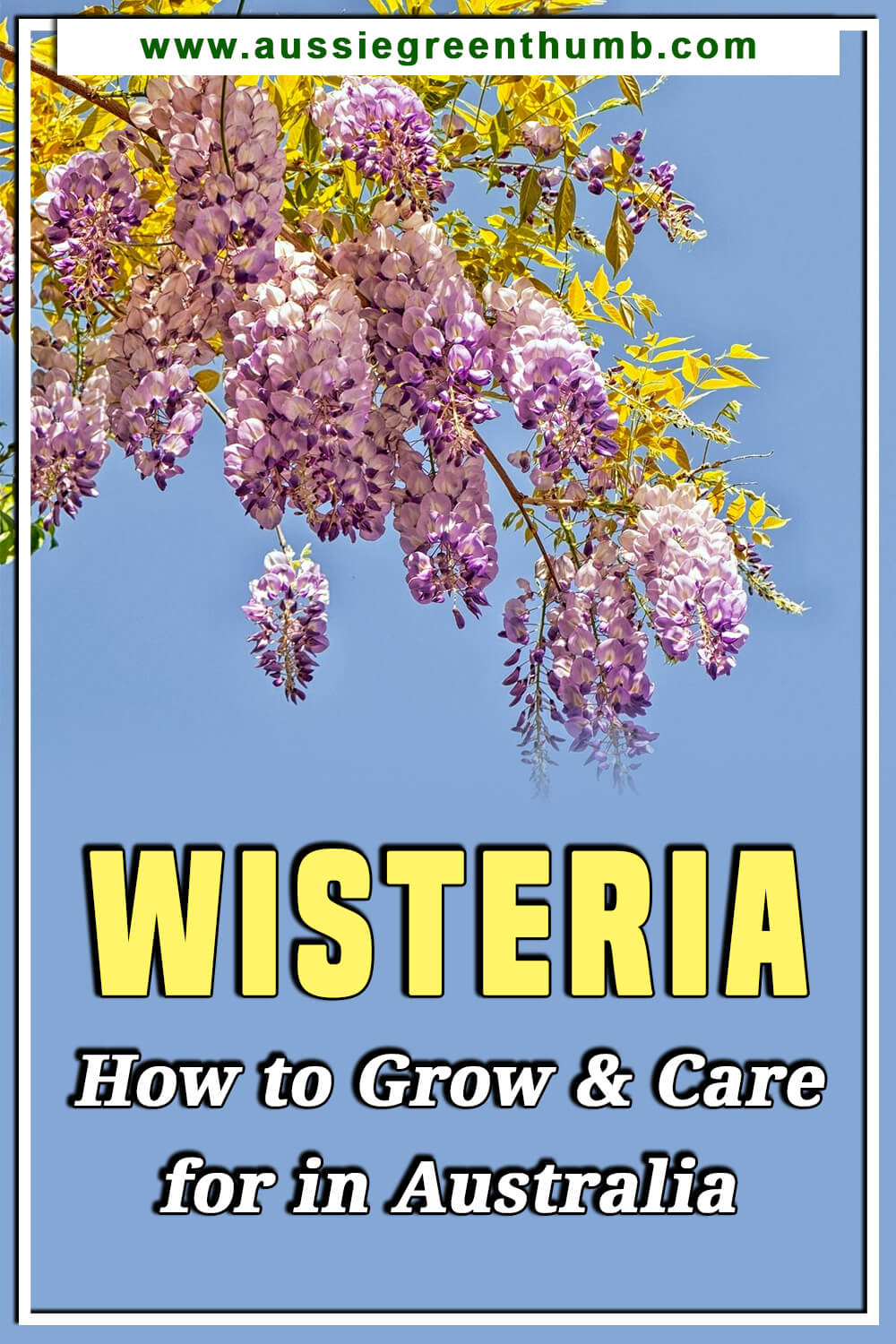
Enjoy Breathtaking Wisteria Floral Display in Your Garden
Deciding to grow a wisteria is a commitment to regular pruning, and making sure it has the right structure to climb. If you need some trellis ideas for your garden, we’ve rounded up the best garden trellis ideas and kits today.
In return, you’ll be rewarded with floral displays that take your breath away. This contrasts perfectly with a vine that is in fact incredibly strong and fast growing, eager to get around.
It’s the perfect balance of softness and strength. Armed with your neem oil spray, you’ll be able to take on unwanted pests and diseases that might threaten your lovely wisteria.
You can easily propagate from cutting or seed, and whichever variety you opt for, the plant will keep you in good company. We’ve given wisteria our green thumbs up!
Published on July 12, 2022 by Lorri Hopkins
Last Updated on October 4, 2025




